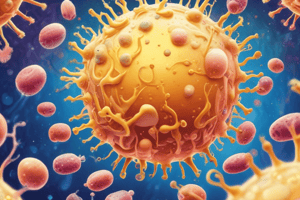Podcast
Questions and Answers
Which of the following Staphylococcus species are coagulase positive?
Which of the following Staphylococcus species are coagulase positive?
- S. aureus, S. intermedius, S. pseudintermedius (correct)
- S. lugdunensis, S. schleiferi, S. epidermidis
- S. aureus, S. epidermidis, S. saprophyticus
- S. hyicus, S. delphini, S. lugdunensis
Which of the following toxins is considered less toxic to cells?
Which of the following toxins is considered less toxic to cells?
- δ-hemolysin (correct)
- β-hemolysin
- γ-hemolysin
- α-hemolysin
What is the mechanism of action of Protein A?
What is the mechanism of action of Protein A?
- It acts on sphingomyelin in the plasma membrane of erythrocytes.
- It binds to the Fc portion of IgG, inhibiting phagocytosis. (correct)
- It directly lyses erythrocytes.
- It binds to the Fab portion of IgG, preventing antibody binding.
Which of the following staphylococcal toxins is lethal to polymorphonuclear leukocytes?
Which of the following staphylococcal toxins is lethal to polymorphonuclear leukocytes?
Which of these is NOT a characteristic of Staphylococci?
Which of these is NOT a characteristic of Staphylococci?
Which of the following staphylococcal species is the most common cause of prosthetic valve endocarditis?
Which of the following staphylococcal species is the most common cause of prosthetic valve endocarditis?
Which of the following is a common source of hospital-acquired infections?
Which of the following is a common source of hospital-acquired infections?
What is the Greek term for "bunches of grapes" which describes Staphylococci's appearance?
What is the Greek term for "bunches of grapes" which describes Staphylococci's appearance?
Which type of toxin is associated with Ritter disease, a skin condition mainly affecting newborns and infants?
Which type of toxin is associated with Ritter disease, a skin condition mainly affecting newborns and infants?
Which of the following staphylococcal species is associated with UTIs in young women?
Which of the following staphylococcal species is associated with UTIs in young women?
What is the basis of the slide coagulase test?
What is the basis of the slide coagulase test?
What is the name of the test used to identify Staphylococci based on their ability to coagulate plasma?
What is the name of the test used to identify Staphylococci based on their ability to coagulate plasma?
Which of these toxins is associated with Staphylococcal pseudomembranous enterocolitis?
Which of these toxins is associated with Staphylococcal pseudomembranous enterocolitis?
Which of these is NOT a type of hemolysin produced by S. aureus?
Which of these is NOT a type of hemolysin produced by S. aureus?
Which of these is a potential consequence of TSS caused by Staphylococci?
Which of these is a potential consequence of TSS caused by Staphylococci?
Which of these is a common characteristic of both Staphylococci and Micrococci?
Which of these is a common characteristic of both Staphylococci and Micrococci?
Which of the following is NOT a characteristic of Staphylococcus aureus?
Which of the following is NOT a characteristic of Staphylococcus aureus?
What is the mechanism by which Staphylococcus aureus develops resistance to methicillin?
What is the mechanism by which Staphylococcus aureus develops resistance to methicillin?
Which of the following statements is TRUE about Staphylococcus lugdunensis?
Which of the following statements is TRUE about Staphylococcus lugdunensis?
What is the name of the gene responsible for methicillin resistance in Staphylococcus aureus?
What is the name of the gene responsible for methicillin resistance in Staphylococcus aureus?
What is the 'gold standard' method for detecting methicillin resistance in Staphylococcus aureus?
What is the 'gold standard' method for detecting methicillin resistance in Staphylococcus aureus?
Which of the following is a TRUE statement about Staphylococcus saprophyticus?
Which of the following is a TRUE statement about Staphylococcus saprophyticus?
Which of the following statements is TRUE regarding the treatment of methicillin-resistant Staphylococcus aureus (MRSA)?
Which of the following statements is TRUE regarding the treatment of methicillin-resistant Staphylococcus aureus (MRSA)?
What is the most appropriate test for determining methicillin resistance in Staphylococcus aureus isolates?
What is the most appropriate test for determining methicillin resistance in Staphylococcus aureus isolates?
Flashcards
Food poisoning
Food poisoning
Illness caused by consuming contaminated food, often linked to staphylococci.
Toxic Shock Syndrome Toxin-1 (TSS Toxin-1)
Toxic Shock Syndrome Toxin-1 (TSS Toxin-1)
A toxin linked to staphylococcal infections causing toxic shock syndrome, especially in menstruating women.
Staphylococci
Staphylococci
Gram-positive cocci, often appear in clusters, catalase-positive, and can cause various infections.
Exfoliative Toxin
Exfoliative Toxin
Signup and view all the flashcards
Ritter Disease
Ritter Disease
Signup and view all the flashcards
Micrococci
Micrococci
Signup and view all the flashcards
Coagulase
Coagulase
Signup and view all the flashcards
Cytolytic Toxins
Cytolytic Toxins
Signup and view all the flashcards
Staphylocoagulase
Staphylocoagulase
Signup and view all the flashcards
Alpha-Hemolysin
Alpha-Hemolysin
Signup and view all the flashcards
Beta-Hemolysin
Beta-Hemolysin
Signup and view all the flashcards
Panton-Valentine leukocidin (PVL)
Panton-Valentine leukocidin (PVL)
Signup and view all the flashcards
Protein A
Protein A
Signup and view all the flashcards
Clumping Factor
Clumping Factor
Signup and view all the flashcards
Staphylococcus epidermidis
Staphylococcus epidermidis
Signup and view all the flashcards
Staphylococcus saprophyticus
Staphylococcus saprophyticus
Signup and view all the flashcards
Staphylococcus lugdunensis
Staphylococcus lugdunensis
Signup and view all the flashcards
Staphylococcus aureus
Staphylococcus aureus
Signup and view all the flashcards
Cutaneous infections
Cutaneous infections
Signup and view all the flashcards
Enterotoxins
Enterotoxins
Signup and view all the flashcards
Methicillin-resistant Staphylococci
Methicillin-resistant Staphylococci
Signup and view all the flashcards
mecA gene
mecA gene
Signup and view all the flashcards
Toxin-induced diseases
Toxin-induced diseases
Signup and view all the flashcards
Oxacillin-salt agar plate
Oxacillin-salt agar plate
Signup and view all the flashcards
Study Notes
Staphylococci
- Gram-positive cocci, arranged in clusters ("bunches of grapes")
- Nonmotile, non-spore-forming, aerobic or facultatively anaerobic
- Catalase-positive
- Several species, including S. aureus, S. epidermidis, S. saprophyticus, S. lugdunensis
- Important in human infections, often causing food poisoning, skin infections, and other diseases.
- S. aureus is the most common and clinically significant species
Staphylococcal Diseases
- Food poisoning: Caused by heat-stable enterotoxins
- Scalded skin syndrome (SSS): Caused by exfoliative toxins
- Toxic shock syndrome (TSS): Caused by toxic shock syndrome toxin-1 (TSST-1)
- Impetigo: Superficial skin infection, can progress deeper
- Cellulitis: Skin infection, can progress deeper
- Carbuncles: Deep skin abscesses
Staphylococcal Toxins
- Enterotoxins: Heat-stable, cause vomiting and diarrhea (A-E, G-J groups)
- Exfoliative toxins: Cause scalded skin syndrome
- Toxic shock syndrome toxin-1 (TSST-1): Causes toxic shock syndrome
- Cytolytic toxins (hemolysins and leukocidins): Damage cells
- Panton-Valentine leukocidin (PVL): Toxin lethal to polymorphonuclear leukocytes
Coagulase
- Enzyme produced by some staphylococci
- Positive test results in clot formation in plasma
Differentiation Between Staphylococci and Micrococci
- Use tests like modified oxidase, anaerobic acid production from glucose/glycerol, resistance to bacitracin, lysosome/lysostaphin assay.
Antimicrobial Susceptibility
- Testing crucial for S. aureus and S. lugdunensis infections
- Testing of S. saprophyticus from urine not usually required
Methicillin-Resistant Staphylococci (MRSA)
- Isolates resistant to nafcillin or oxacillin
- Vancomycin often the treatment of choice for MRSA and MRSE
- Screening for MRSA involves oxacillin-salt agar plate and/or detection of the mecA gene
Vancomycin-Resistant Staphylococci
- Vancomycin often the drug of choice
- Infections may require different approaches, emphasizing prompt testing
Macromolecule Resistance
- Modified disk diffusion tests used to assess resistance
- Resistance mechanisms can affect treatment pathways
Diagnostic Procedures
- Gram stains, catalase tests, coagulase tests
- Differentiating tests used to identify specific staphylococcal and micrococcal species
Studying That Suits You
Use AI to generate personalized quizzes and flashcards to suit your learning preferences.





